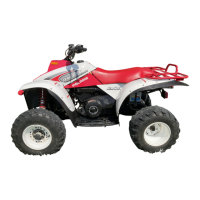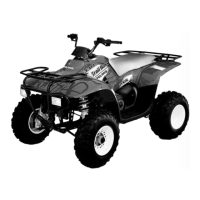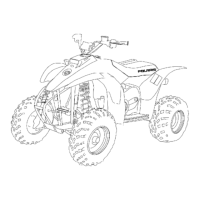CLUTCH
6.9
RELATIONSHIP OF DRIVE CLUTCH WEIGHTS AND S PRING IN
MAINTAINING OPERATING
RPM
The drive clutch is an RPM and torque sensing unit designed to transfer the maximum amount of horsepower
from the engine to the ground. This is accomplished through weights and a spring inside the unit which react to
the centrifugal force applied to the clutch from the engine RPM.
The spring and weights work in combination. In a properly set up clutch, the maximum desired operating RPM
will be reached immediately after clutch engagement, under full throttle conditions. To gain optimum power this
RPM should be maintained. As centrifugal force pushes the weights against the rollers, the moveable sheave
will force the belt to climb up the drive clutch sheave and increase vehicle speed.
If the weights and spring are matched
properly, the engine RPM will go to the
desired range and remain there on both
the upshift and backshift.
If the weights are too light, or the spring
rate too high, the maximum RPM will be
too great and the drive belt will not move
into high gear at the top of the clutch.
If the weights are too heavy, or the spring
rate too low , the engine RPM will be low
and the drive clutch will upshift too fast,
keeping the engine out of its power
band.
Example : Engine Operating RPM 6000 ¦200
2000
3000
4000
5000
6000
7000
8000
CLUTCH
ENGAGEMENT
RPM
2000
3000
4000
5000
6000
7000
8000
CLUTCH
ENGAGEMENT
RPM
2000
3000
4000
5000
6000
7000
8000
CLUTCH
ENGAGEMENT
RPM
1000
1000
1000

